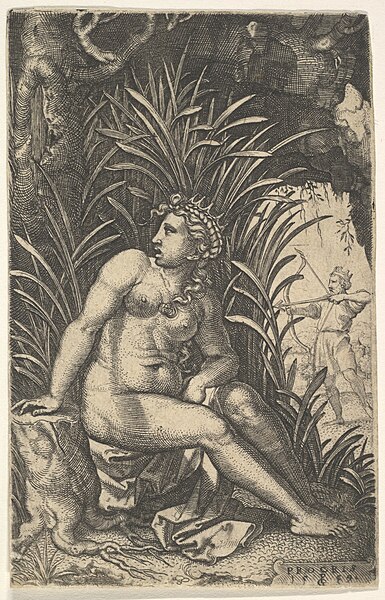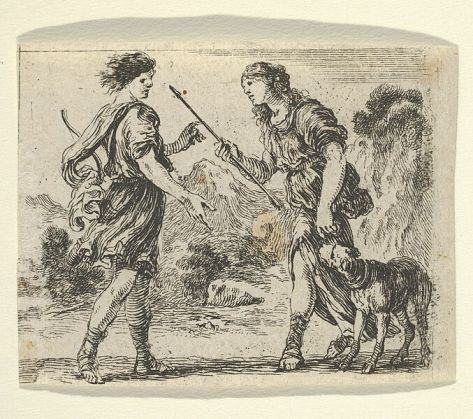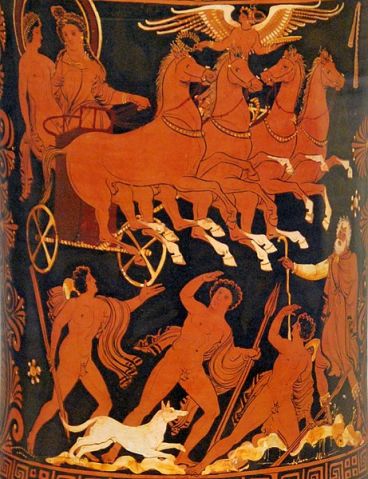Cephalus is a hero not as renowned as Hercules or Theseus, yet his story, marked by passion and tragedy, holds a mirror to the very essence of human emotions and frailties. Dive into the life of Cephalus, exploring his lineage, adventures, and the love that defined his place in the annals of mythology.
Cephalus Key Facts
| Parents | Deioneus (or Deione) and Diomede |
| Partners | Procris, Eos, and Clymene |
| Siblings | Actor, Aenetus, Phylacus, and Asterodia |
| Offspring | Arcesius and possibly others |
| Other names | Kephalos |
| Roman name | Not prominently mentioned |
| Best Known Myth | His tragic love story with Procris |
Name and Etymology
Cephalus, often referred to as Kephalos in some texts, has a name that’s deeply rooted in the Greek language. The term “kephalē” in Greek means “head”, which might hint at his leading or prominent role in the myths he’s featured in. His Roman counterpart goes by the same name, Cephalus, showing the significant influence and importance of his character even beyond Greek culture. Throughout various tales and regions, he might be known by epithets or alternative names, but Cephalus remains the most recognized.
Cephalus Family and Relationships
Cephalus, or Kephalos as he’s also known, is a figure of considerable importance in Greek mythology, not just for his own deeds but also due to his illustrious lineage. He was the son of Deioneus, the king of Phocis, and Diomede, the daughter of Xuthus. This union of royalty and nobility made Cephalus’s birth a celebrated event.

His romantic journey was a roller-coaster of emotions. His love story with Procris is legendary, marked by deep passion, misunderstandings, and a tragic end. However, before his reunion with Procris, he was abducted by Eos, the goddess of dawn, who was smitten by his charm. Despite her divine allure, Cephalus’s heart remained anchored to Procris, leading to his eventual return.
After the heart-wrenching death of Procris, Cephalus found companionship with Clymene. Some myths even suggest that Clymene might have taken the form of a she-bear. Their relationship, while not as renowned as his tale with Procris, signifies Cephalus’s ability to find love and solace even after profound loss.
The legacy of Cephalus is multifaceted. From his noble birth to his various romantic liaisons and the tragic tale with Procris, his story is a rich tapestry of love, loss, and legacy.
Myths about Cephalus
Cephalus’s life, woven with threads of passion, tragedy, and redemption, offers a rich tapestry of tales that highlight the complexities of love and fate in Greek mythology.
The Tragic Love of Cephalus and Procris

Cephalus and Procris were the epitome of young love, their bond seemingly unbreakable. However, as with many tales of passion, theirs was not without its trials. A seed of doubt was planted in Procris’s heart, leading her to believe that Cephalus might be unfaithful. In an attempt to confirm her suspicions, she followed him during one of his hunting trips. A series of tragic misunderstandings ensued. Cephalus, hearing a rustling in the bushes and believing it to be game, threw his spear, inadvertently striking and fatally wounding Procris. The heart-wrenching realization of his mistake and their final moments together serve as a poignant reminder of the fragility of trust and the irreversible consequences of doubt.
Abduction by Eos

Eos, with her rosy fingers heralding the dawn, was no stranger to the allure of mortal men. When her eyes fell upon Cephalus, she was instantly captivated. Without hesitation, she whisked him away to her divine abode. In the ethereal surroundings of her palace, Eos tried to drown Cephalus in luxuries and divine affection. Yet, every day, Cephalus’s heart echoed with memories of Procris. His tales of their love, filled with longing and sorrow, moved even the immortal heart of Eos. Recognizing the depth of their bond and the futility of her efforts, Eos, in a rare act of compassion, released Cephalus, allowing him to reunite with his mortal love.
Cephalus and Clymene
The shadow of Procris’s tragic death loomed large over Cephalus. His heart, once filled with joy, was now a vessel of grief and remorse. But fate, ever unpredictable, had another chapter in store for him. He encountered Clymene, a unique figure who, in some versions of the myth, is described as a she-bear transformed into a woman. Their relationship, while unexpected, brought a semblance of solace to Cephalus’s tormented heart. From their union came a son, a beacon of hope and a testament to Cephalus’s ability to find love again, even amidst the ruins of his past.
Mentions in Ancient Texts
Cephalus has graced various ancient texts with his tale.
Ovid’s “Metamorphoses”
Written around 8 AD, Ovid’s “Metamorphoses” provides a detailed account of Cephalus and Procris’ story. In this text, the tragic misunderstanding that leads to Procris’ death is poignantly described. A notable excerpt reads, “Mistaken in the shadowy light, he threw his javelin at Procris…”
Homer’s “Odyssey”
In Homer’s “Odyssey”, Cephalus is indirectly referenced through his descendants. Arcesius, the son of Cephalus, is mentioned as the grandfather of the epic’s protagonist, Odysseus. This connection ties Cephalus to one of the most significant heroes of Greek mythology and emphasizes the importance of his lineage.
Plato’s “Republic”
Cephalus also makes an appearance in Plato’s “Republic”. Here, he is depicted as a wealthy metic and elderly arms manufacturer living in Athens. He engages in a dialogue with Socrates, discussing the nature of justice and the ideal state. This portrayal of Cephalus offers a glimpse into his character outside of the myths, showcasing his philosophical inclinations and his place in Athenian society.
Hesiod’s “Theogony”
In Hesiod’s “Theogony”, Cephalus is described as being beloved by the goddess Dawn (Eos, or Aurora). She was so infatuated with him that she carried him off to live with her on Mount Olympus. With his hound, Laelaps, Cephalus overcame challenges like the vixen of Teumessus that had ravaged Boeotia.
Frequently Asked Questions
Cephalus is best known for his tragic love story with Procris, which ended in accidental tragedy.
He was the son of Eosphorus and Dawn.
Yes, the dog and the javelin are frequently linked with Cephalus due to their significance in his myth.
Yes, he had two sons named Arcesius and Phylacus.
He’s often depicted as a young man with hunting gear, symbolizing his tragic hunting accident.
Featured Image Credit: French Neoclassical School, CC0, via Wikimedia Commons
